Male sterility, as the name indicates, is the inability of a plant to produce a male reproductive organ, the viable pollen. Male sterility can occur due to extra-nuclear genetic or nuclear genetic conditions.
Cytoplasmic Male Sterility (CMS) refers to the inability of a plant to produce viable pollens due to cytoplasm-based extranuclear genetic conditions under the control of the mitochondrial or plastid genomes. In general, there are two types of cytoplasm: N (normal) and aberrant S (sterile) cytoplasms. These types exhibit reciprocal differences.
- Cytoplasmic male sterility is governed by cytoplasmic or plasma genes.
- CMS is a maternally inherited phenomenon.
- It doesn’t follow the Mendelian pattern of inheritance.
- CMS has now been identified in over 150 plant species
- The progeny of a male sterile plant is always male sterile, as its cytoplasm is derived entirely from a female gamete.
- CMS is not very common in the plant kingdom.
- The nuclear genotype of the male sterile line is almost identical to that of the recurrent pollinator strain.
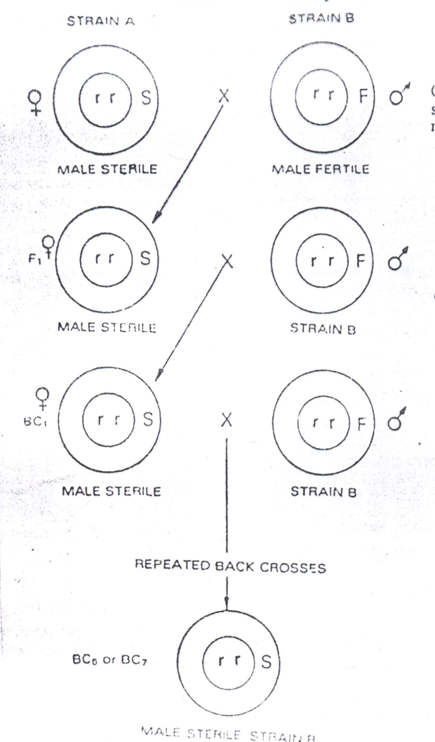
Maintaining cytoplasmic male sterile lines
In the system, there is A and B line.
The male sterile line is known as the A-line which is used to maintain the male sterile line while the male fertile is the B line. The A-line is maintained by crossing it with the B line (pollinator strain used as the recurrent parent in the backcrossing program), as its nuclear genotype is identical to that of the A-line.
Examples – Observed in maize, wheat, rice, sorghum, and cotton.
Molecular Basis of CMS
Most types of CMS are caused by the expression of aberrant chimeric genes located in mitochondrial genomes.
Chimeric genes, literally mutated genes, form through the combination of portions of two or more coding sequences to produce new genes which merge whole gene sequences into a single reading frame and often retain their original functions.
Cytoplasmic male sterility occurs in many plant species and is often associated with chimeric mitochondrial open reading frames. In a number of cases, transcripts originating from these altered open reading frames are translated into unique proteins that appear to interfere with pollen development.
A number of CMS-determining genes have been identified. These include the T-urf13 gene in T-cytoplasm Maize, Pcf in Petunia, orf138 and orf224 in Brassica, and orf79 and orfH79 in Rice. These genes are unusual open reading frames (ORFs) that have resulted from mitochondrial DNA rearrangements.
In many cases, male fertility of CMS plants can be overcome by certain nuclear-encoded gene(s) called restorer-of-fertility (Rf). Nuclear restorer (Rf or Fr) genes function to suppress the deleterious effects of CMS-associated mitochondrial abnormalities by diverse mechanisms. This interaction results in a new sterility type called Cytoplasmic Genetic Male Sterility.
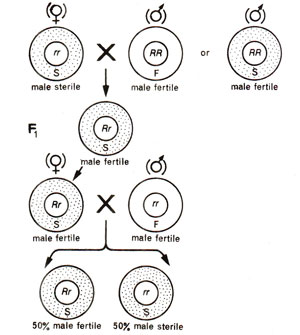
Application of CMS in plant breeding
Hybrid seed production
- Cytoplasmic male sterility is used to facilitate the production of hybrid seed in species where a vegetative part is of economic value.
- Hybrid seed is produced from a cross between two genetically different lines; such seeds usually result in a larger, more vigorous plants.
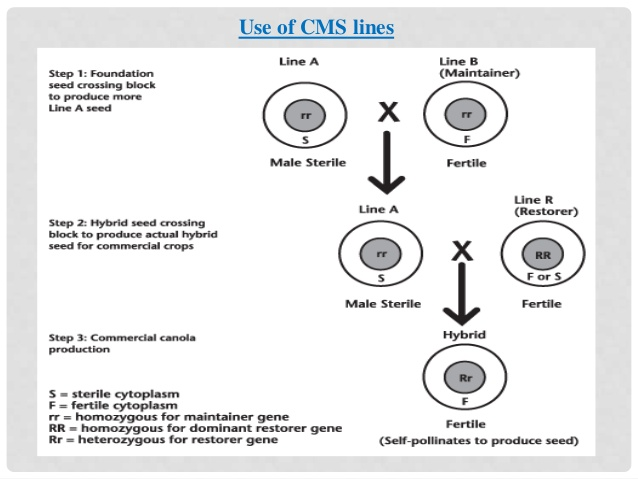
- The main practical problem in producing hybrid seeds is to prevent self-pollination, which would produce seeds that are not hybrid. One breeding scheme is illustrated not for crop plants where the seed is the economic part because the hybrid progeny would be male sterile i.e no seed formation.
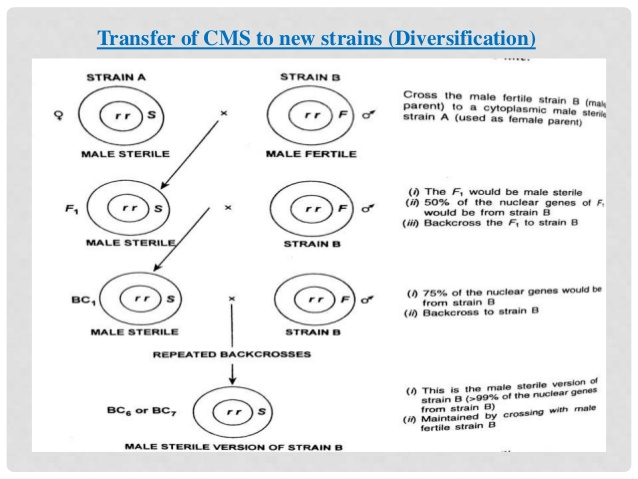
or understand this schematic diagram.
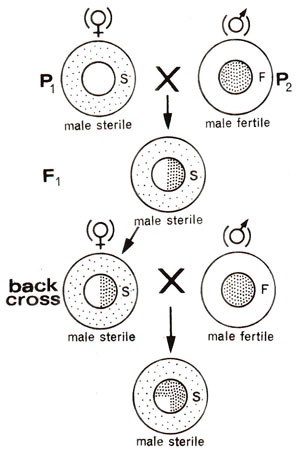
- This type of male sterility is found in onion, fodder, jowar, cabbage, etc.
Hybrid Maize breeding
- Cytoplasmic male sterility is an important part of hybrid maize production. The first commercial cytoplasmic male sterility, discovered in Texas is known as CMS-T.
- The use of CMS-T started in the 1950s eliminated the need for detasseling.
- In the early 1970s, plants containing CMS-T genetics were susceptible to southern corn leaf blight and suffered from widespread loss of yield. Since then CMS types C and S are used.
Origin of CMS
- Intergeneric crosses
- Interspecific crosses
- Intraspecific crosses
- Mutagens (EMS, EtBr)
- Antibiotics (streptomycin and Mitocin)
- Spontaneous
Advantages of CMS
- Highly stable and not influenced by environmental conditions.
- Used in hybrid seed production.
- It is applicable in the production of hybrids in ornamental crops and vegetatively propagated crops, overall, where grain or fruit is not the economic product.
Limitations of CMS
- Not used where the seed is the economic product.
- CMS line has inferior agronomic performance.
- There are certain drawbacks to the method. It can not be used in asexually propagated crops, to produce hybrids in crops where improvement in seed/fruit is considered.
Source:
- Fig 2: https://biocyclopedia.com/index/genetics/maternal_effects_and_cytoplasmic_inheritance/male_sterility_in_plants.php
- Fig 5:
https://biocyclopedia.com/index/genetics/maternal_effects_and_cytoplasmic_inheritance/male_sterility_in_plants.php
 Plantlet The Blogging Platform of Department of Botany, University of Dhaka
Plantlet The Blogging Platform of Department of Botany, University of Dhaka





